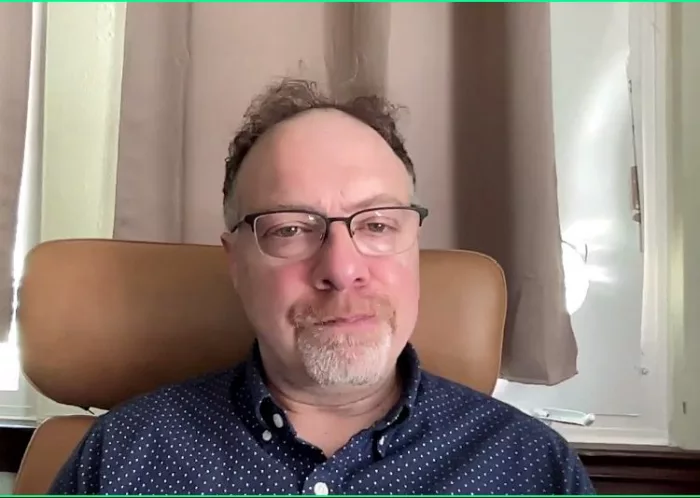
By Michael LaGamma
Dr. Adam Riess, a Bloomberg Distinguished Professor at Johns Hopkins University and the Space Telescope Science Institute, addressed the April 23rd meeting of the Greenwich Retired Men’s Association, sharing the remarkable story behind the discovery that the universe’s expansion is accelerating.
Introduced by RMA members Jay Schondorf and Jim Fishbein, Dr. Riess’s talk offered insights into cutting-edge cosmology, its challenges, and the profound questions that remain. Schondorf, who is Dr. Riess’s father-in-law and has been an RMA member for 13 years, highlighted the personal connection, noting that his daughter Nancy had met Dr. Riess at MIT and they were married at the Greenwich Hyatt in 1998. Fishbein, an RMA member who has presented a series on astronomy, noted Dr. Riess’s status as the first Nobel Prize winner to address the group.
Dr. Riess, who shared the 2011 Nobel Prize in Physics for his work, explained that while the expansion of the universe had been known for nearly a century, the unexpected finding was that this expansion is speeding up, propelled by what is now called dark energy.
He described cosmology as the study of the structure and development of the universe. A key challenge in cosmology, Dr. Riess explained, is measuring vast cosmic distances. Drawing parallels to earthly methods like parallax or using “lighthouses” of known brightness, he detailed how astronomers use “standard candles” in space. These are objects whose intrinsic luminosity is understood, allowing their observed brightness to reveal their distance. One crucial type of standard candle is the Type Ia supernova, the explosion of a white dwarf star that exceeds a critical mass, known as the Chandrasekhar limit. Discovered decades ago by astronomer Edwin Hubble, the expansion of the universe is observed through a relationship known as Hubble’s Law, where distant galaxies appear to move away faster. This apparent motion is measured by redshift, a stretching of light wavelengths caused by the expansion of space itself. Measuring the expansion rate allows cosmologists to estimate the age of the universe. Early measurements by Edwin Hubble implied a universe only 2 billion years old, which was known to be incorrect even at the time. Over decades, as measurement techniques improved, including the use of supernovae, the age estimate grew to the current value of 13 to 14 billion years.
Cosmologists pondered the fate of the universe based on its expansion velocity and mass, much like considering the trajectory of a cannonball fired from Earth. However, Dr. Riess recounted how Albert Einstein, while developing his theory of general relativity, considered the possibility that empty space itself could possess repulsive gravity, introducing what he called the cosmological constant. Although Einstein initially deemed this his “biggest blunder” after Edwin Hubble confirmed the universe was expanding, the idea of repulsive gravity remained a possibility.
The universe’s vast distances provide a unique record of the past, as light from distant objects takes billions of years to reach us. Looking at more distant objects reveals the universe’s state further back in time. By the 1990s, scientists realized this allowed them to measure whether the universe’s expansion was slowing down due to gravity. Dr. Riess, working with the High-Z Supernova Team, set out to measure this expected slowing by comparing distant and nearby supernovae. His initial analysis yielded a result implying negative mass, which didn’t make sense, but it suggested the universe expansion was actually accelerating, not decelerating.
An email chain among colleagues reflected the surprise and skepticism this finding generated just before Dr. Riess’s wedding in 1998. Colleagues like Alex Filippenko remarked on the surprising data. Bruno Leibundgut questioned if they were prepared to defend the result. Brian Schmidt, with whom Dr. Riess would later share the Nobel Prize, also found it perplexing. Robert Kirshner, Dr. Riess’s thesis advisor, felt it would be “silly” to announce a non-zero cosmological constant and then retract it. Despite the initial hesitation, the team, including members like Mark Phillips, John Tonry, Alejandro Clocchiatti, and Nick Suntzeff, ultimately agreed to report their observations. A competing team from Lawrence Berkeley National Lab reached the same conclusion with independent data shortly thereafter. The finding was named the “breakthrough discovery of the year” by Science Magazine in 1998.
Acceptance of the accelerating universe took about a decade, requiring cross-verification through other cosmological observations. These included measurements of the Integrated Sachs-Wolfe effect, studies of the radiation left over from the Big Bang, observations of galaxy clusters, and measurements of the universe’s scale. Dr. Riess noted winning the Nobel Prize in 2011 solidified the acceptance of the work.
Despite this confirmation, the exact nature of dark energy remains a mystery. Potential explanations include vacuum energy, temporary field energy, or a modification of Einstein’s theory of gravity. Dr. Riess highlighted a current challenge: the “Hubble constant tension,” a discrepancy between the expansion rate measured using nearby objects and the rate predicted from observations of the early universe. This tension suggests there might be missing elements in the standard cosmological model, known as Lambda-CDM which describes the universe as being composed of about 25% dark matter, 70% dark energy, and 4% ordinary matter.
Future missions, like the Euclid space telescope and the Nancy Grace Roman Space Telescope aim to gather more data to address these questions. Dr. Riess expressed concern about proposed significant cuts to astrophysics funding for NASA and other scientific bodies like the NSF and NIH, noting the potential negative impact on research progress and the future of young scientists. He underscored the importance of basic science research, citing how Einstein’s seemingly esoteric work on general relativity became fundamental to modern technologies like GPS. Ultimately, understanding dark energy is crucial because it dominates the universe, dictates its fate, and lies at the intersection of quantum theory and general relativity, two fundamental but currently incompatible theories of physics. The significant discrepancy between the dark energy predicted by theory and what is observed indicates something profound about physics remains unknown.
A robust question and answer session followed.
The RMA’s upcoming presentation, “Art Fakes and Forgeries” by Serdar Arat, is scheduled for 11 AM on Wednesday, May 7, 2025. Note: This and future RMA presentations will be held at Christ Church Greenwich, Parish Hall, 254 E. Putnam Avenue, Greenwich, CT 06830.
Art fakes and forgeries give us the combined satisfaction of a crime mystery and the profound contemplation of what we expect from art in the first place. As fakes get more outrageous and damaging, some forgers enjoy celebrity status, their fakes are studied in museum exhibitions, and museums around the world are full of undetected fakes. We will explore how forgers convince, how they are detected, and why authenticity matters.
Serdar Arat is a visual artist of Turkish origin, living and working in NY since 1980, with nearly 40 one-person and 60 group exhibitions primarily in New York City and İstanbul. Many reviews and articles about his work include half a dozen in The New York Times, a monograph by Bill Arning, a documentary film by Ken Calhoun among others. Recipient of a Pollock Krasner Foundation Grant, his works are in many public and private collections mainly in the USA and Turkey. He has also served as a faculty member and gallery director/curator until 2018, and currently continues to present lectures at the intersection of art and issues of interest. His website is www.serdararat.com.
To stream the presentation by Serdar Arat at 11 AM on Wednesday, May 7, click on https://bit.ly/30IBj21. This presentation will also be available on local public access TV channels, Verizon FIOS channel 24 and Optimum (Cablevision) channel 79.
Note: The views expressed in these presentations are those of the speakers. They are not intended to represent the views of the RMA or its members.
RMA speaker presentations are presented as a community service at no cost to in-person or Zoom attendees, regardless of gender. Any member of the public who would like to receive a weekly email announcement of future speakers should send a request to members@greenwichrma.org. The RMA urges all eligible individuals to consider becoming a member of our great organization, and thereby enjoy all the available fellowship, volunteer, and community service opportunities which the RMA offers to its members. For further information, go to https://greenwichrma.org/, or contact info@greenwichrma.org.




